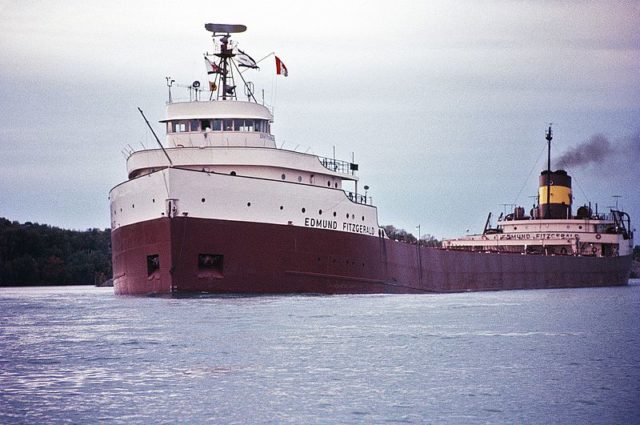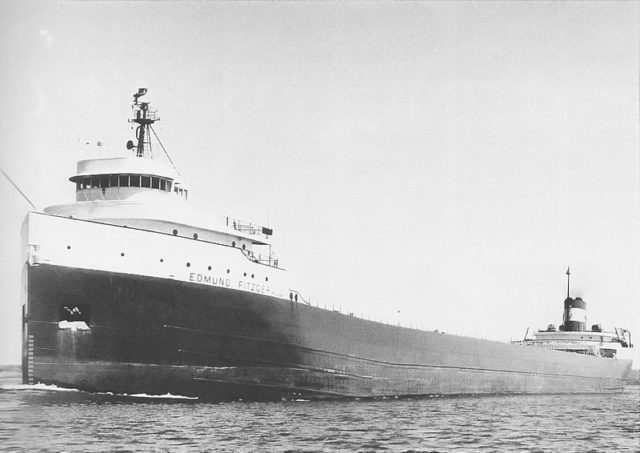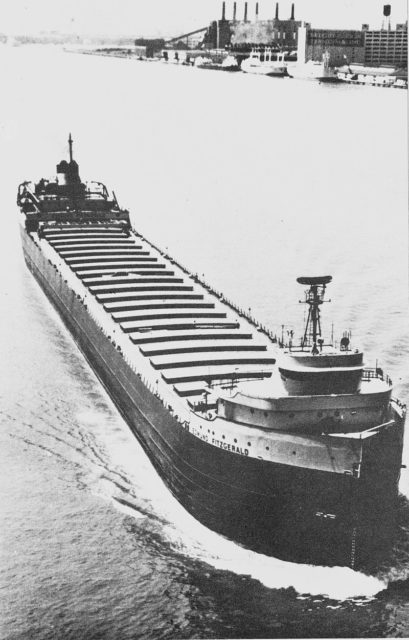The Great Lakes cargo ship Edmund Fitzgerald disappeared on November 10, 1975, under very mysterious circumstances. Ever since then, her disappearance has been the focus of much speculation, with some theories more far-fetched than others.
The ship was being captained by Ernest M. McSorley and, carrying nearly 27,000 tons of taconite pellets, departed the Burlington Northern Railroad Dock in Superior, Wisconsin around 2:30 pm, November 9th. The Fitzgerald had been hauling taconite – iron ore processed into marble-sized pellets – for 17 years.
She was well-known on Lake Superior as the largest freighter on the Great Lakes at the time, and she held several hauling records. She is still the largest ship to have sunk on Lake Superior.

Another ship bound for Detroit, the Arthur M. Anderson, rendezvoused with the Fitzgerald after having departed from Two Harbors, Minnesota. The vast majority of first-hand information about Fitzgerald’s sinking comes from the Anderson‘s captain, Bernie Cooper, whose crew was in contact with McSorley right up until the end.
Since Fitzgerald was faster than Anderson, she was ahead on the lake by about 10 to 15 miles. Because they knew a heavy storm was forming over the Great Lakes, both captains agreed to chart a course across Superior on the northern side. This route, they thought, would provide shelter with the protection of the highlands and the Canadian shore. They would steam between Keweenawan Peninsula and Isle Royale. Their intent was to turn southeast and towards Whitefish Point, which could provide even more shelter from the storm.

By the morning of November 10th, the gale warnings issued the previous day had been upgraded to severe. Wind speeds increased to 50 knots, with 12 to 16-foot waves. However, both captains had successfully piloted their ships through similar storm situations frequently. Even though conditions continued to worsen by the hour that day, both ships sailed on. Fitzgerald nearly reached Caribou Island, but the slower Anderson was behind, just approaching Machicote, almost four miles from West End Light.
Cooper later reported that he had seen the Fitzgerald get closer than she should have to Six Fathom Shoal, which is north of Caribou Island. On his radar, Cooper could calculate the distance between the Fitzgerald and the beacon on Caribou. With nothing to do but watch, he and his crew saw McSorley’s ship cross over an area of shallow water that was known to be dangerous. Snow and spray prevented them from seeing the Fitzgerald, 17 miles ahead by this time, except on radar.
The Fitzgerald made radio contact to report she had a fence rail down and damage or loss of two vents, and also that she was listing. Fitzgerald’s captain also reported he was heading down to assess the damage. Cooper asked if the Fitzgerald’s pumps were working and McSorley responded, “Yes, both of them.” McSorley had slowed his ship’s speed to close the distance between her and the Anderson. Cooper ordered his crew to keep Fitzgerald in sight on radar.

The Anderson began to suffer her own damage. A strong wave hit starboard and rendered her lifeboat on that side inoperative. Cooper remembered winds out of the northwest and west at 58 knots, and gusting to 70 knots, with 18 to 25 feet seas.
Morgan Clark, Anderson’s first mate, kept watch on the radar and stayed in communication with Fitzgerald on the radio. At about 7:10 PM he heard the last communication from Fitzgerald. Clark asked McSorley how he was, “…making out with your problems?”. McSorley replied, “We are holding our own.” It was the last communication from the Fitzgerald.
Once the weather died down, Anderson responded as the main vessel in the search for Fitzgerald and any survivors. Two lifeboats and debris were located, but no survivors. The US Coast Guard, as well as three other ships, joined the search over the course of four days.

By November 14th, a US Navy plane had come in on the search, using a magnetic anomaly detector. Its crew eventually discovered two large pieces of Fitzgerald’s wreckage. But it wasn’t until May 20, 1976 when the final resting place of the Fitzgerald was located.
The US Coast Guard’s official report stated that the Fitzgerald sank due to flooding caused by improper hatch closures. The Lake Carrier’s Association disagreed vehemently with this finding, however. Theories are conflicting to this day as to why the carrier floundered and sank. There have been three expeditions to her resting site. The ship rests on the bottom of Lake Superior in two pieces. One theory is that the ship may have “submarined”, which means it went bow first under the waves. This type of sinking is powerful and extremely destructive to the structure of a ship.

The sinking of Fitzgerald caused the loss of 29 men, and yet to this day there is still no definitive reason why she went down.
Read another story from us: New book featuring ships lost on the Canadian Great Lakes highlights the Ghost Fleet of Lake Huron
Her bell was recovered and is now displayed in the Great Lakes Shipwreck Museum as a memorial to the lost men of the Edmund Fitzgerald. Writer: Mary Jesson